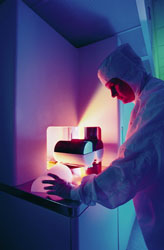Transitioning from silicon to organic electronic devices
Self-assembled monolayers (SAMs) of organic molecules are the subject of intense research and development for their potential role in the formation of organic electronics through self-assembly. Organic molecules provide a diversity and complexity not seen in inorganic chemistry. Furthermore, they can be realised on flexible substrates and are compatible with low-cost processing techniques. Of particular interest, they could hold the key to the further miniaturisation of electronics with improved functionalities. This goal is likely to be no longer technically or economically feasible with conventional Si-based complementary metal-oxide semiconductor (CMOS) devices within the next decade. In order to bridge a transition, novel molecular electronics must be compatible with current CMOS technology. EU-funded scientists developed CMOS-compatible electrodes formed from metal–molecule–metal junctions within the context of the project 'Towards CMOS-compatible molecular electronics' (TO COME). The focus was on compatibility with noble metal electrodes other than gold, the latter of which has already been used in molecular electronics. Scientists chose palladium (Pd) for its reduced surface mobility relative to gold and its relative abundance. Investigators developed a high-resolution scanning tunnelling microscopy (STM) and scanning tunnelling spectroscopy (STS) setup housed in a noise-free lab to study molecular processes and electrochemical parameters in situ. The equipment was used to characterise various anchor groups as alternatives to thiols and with the goal of enhancing electronic coupling at the molecule–metal interface to reduce resistance to current flow. The team developed techniques for fabrication of ultra-flat Pd substrates to study SAM thin films. The novel cost-effective method produced metal films with atomic-scale smoothness. Researchers then studied molecular self-assembly and adsorption using the STM setup that allowed tracking of single-molecule motion. They also studied the molecular systems when partially decoupled from the substrate. This is of considerable importance in fabricating organic gates in thin-film transistors. Finally, researchers fabricated nanopore devices in which molecules were trapped in lithographically formed nanopores etched into the ultra-flat metal substrates. TO COME scientists developed novel ultra-flat metal platforms facilitating SAM adsorption with a wide range of molecules. The on-chip SAMs represent an important transition from CMOS devices to organic or molecular electronics with exciting functionalities in ever-smaller packages.



